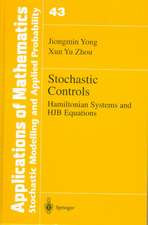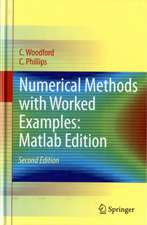Representations for Genetic and Evolutionary Algorithms: Studies in Fuzziness and Soft Computing, cartea 104
Autor Franz Rothlauf Cuvânt înainte de D.E. Goldbergen Limba Engleză Paperback – 18 apr 2012
| Toate formatele și edițiile | Preț | Express |
|---|---|---|
| Paperback (2) | 333.04 lei 6-8 săpt. | |
| Physica-Verlag HD – 18 apr 2012 | 333.04 lei 6-8 săpt. | |
| Springer Berlin, Heidelberg – 14 oct 2010 | 946.72 lei 6-8 săpt. | |
| Hardback (1) | 952.89 lei 6-8 săpt. | |
| Springer Berlin, Heidelberg – 10 ian 2006 | 952.89 lei 6-8 săpt. |
Din seria Studies in Fuzziness and Soft Computing
- 20%
 Preț: 999.85 lei
Preț: 999.85 lei - 20%
 Preț: 653.06 lei
Preț: 653.06 lei - 20%
 Preț: 872.98 lei
Preț: 872.98 lei - 20%
 Preț: 930.57 lei
Preț: 930.57 lei - 20%
 Preț: 1051.00 lei
Preț: 1051.00 lei - 20%
 Preț: 992.44 lei
Preț: 992.44 lei - 20%
 Preț: 655.85 lei
Preț: 655.85 lei - 20%
 Preț: 1001.86 lei
Preț: 1001.86 lei - 18%
 Preț: 954.14 lei
Preț: 954.14 lei - 20%
 Preț: 330.10 lei
Preț: 330.10 lei - 20%
 Preț: 997.56 lei
Preț: 997.56 lei -
 Preț: 391.61 lei
Preț: 391.61 lei - 20%
 Preț: 647.79 lei
Preț: 647.79 lei - 20%
 Preț: 986.01 lei
Preț: 986.01 lei - 18%
 Preț: 958.56 lei
Preț: 958.56 lei - 20%
 Preț: 996.40 lei
Preț: 996.40 lei - 20%
 Preț: 999.35 lei
Preț: 999.35 lei - 15%
 Preț: 646.43 lei
Preț: 646.43 lei - 20%
 Preț: 651.57 lei
Preț: 651.57 lei - 20%
 Preț: 997.89 lei
Preț: 997.89 lei - 15%
 Preț: 641.03 lei
Preț: 641.03 lei - 20%
 Preț: 1009.74 lei
Preț: 1009.74 lei - 20%
 Preț: 992.62 lei
Preț: 992.62 lei -
 Preț: 388.72 lei
Preț: 388.72 lei - 18%
 Preț: 1223.43 lei
Preț: 1223.43 lei - 20%
 Preț: 651.42 lei
Preț: 651.42 lei - 18%
 Preț: 951.59 lei
Preț: 951.59 lei - 18%
 Preț: 948.61 lei
Preț: 948.61 lei
Preț: 333.04 lei
Preț vechi: 416.30 lei
-20% Nou
Puncte Express: 500
Preț estimativ în valută:
63.73€ • 69.21$ • 53.54£
63.73€ • 69.21$ • 53.54£
Carte tipărită la comandă
Livrare economică 22 aprilie-06 mai
Preluare comenzi: 021 569.72.76
Specificații
ISBN-13: 9783642880964
ISBN-10: 3642880967
Pagini: 308
Ilustrații: XIV, 290 p.
Dimensiuni: 155 x 235 x 16 mm
Greutate: 0.44 kg
Ediția:Softcover reprint of the original 1st ed. 2002
Editura: Physica-Verlag HD
Colecția Physica
Seria Studies in Fuzziness and Soft Computing
Locul publicării:Heidelberg, Germany
ISBN-10: 3642880967
Pagini: 308
Ilustrații: XIV, 290 p.
Dimensiuni: 155 x 235 x 16 mm
Greutate: 0.44 kg
Ediția:Softcover reprint of the original 1st ed. 2002
Editura: Physica-Verlag HD
Colecția Physica
Seria Studies in Fuzziness and Soft Computing
Locul publicării:Heidelberg, Germany
Public țintă
Professional/practitionerCuprins
1. Introduction.- 1.1 Purpose.- 1.2 Organization.- 2. Representations for Genetic and Evolutionary Algorithms.- 2.1 Genetic Representations.- 2.2 Genetic and Evolutionary Algorithms.- 2.3 Problem Difficulty.- 2.4 Existing Recommendations for the Design of Efficient Representations for Genetic and Evolutionary Algorithms.- 3. Three Elements of a Theory of Genetic and Evolutionary Representations.- 3.1 Redundancy.- 3.2 Building Block-Scaling.- 3.3 Distance Distortion.- 3.4 Summary and Conclusions.- 4. Time-Quality Framework for a Theory-Based Analysis and Design of Representations.- 4.1 Solution Quality and Time to Convergence.- 4.2 Elements of the Framework.- 4.3 The Framework.- 4.4 Implications for the Design of Representations.- 4.5 Summary and Conclusions.- 5. Analysis of Binary Representations of Integers.- 5.1 Two Integer Optimization Problems.- 5.2 Binary String Representations.- 5.3 A Theoretical Comparison.- 5.4 Empirical Results.- 5.5 Conclusions.- 6. Analysis of Tree Representations.- 6.1 The Tree Design Problem.- 6.2 Prüfer Numbers.- 6.3 The Link and Node Biased Encoding.- 6.4 The Characteristic Vector Encoding.- 6.5 Conclusions.- 7. Design of Tree Representations.- 7.1 Network Random Keys (NetKeys).- 7.2 A Direct Tree Representation (NetDir).- 8. Performance of Genetic and Evolutionary Algorithms on Tree Problems.- 8.1 GEA Performance on Scalable Test Tree Problems.- 8.2 GEA Performance on the Optimal Communication Spanning Tree Problem.- 8.3 Summary.- 9. Summary, Conclusions and Future Work.- 9.1 Summary.- 9.2 Conclusions.- 9.3 Future Work.- A. Optimal Communication Spanning Tree Test Instances.- A.1 Palmer’s Test Instances.- A.2 Raidl’s Test Instances.- A.3 Berry’s Test Instances.- A.4 Real World Problems.- References.- List of Symbols.- List ofAcronyms.
Caracteristici
A theory of representations is not taken as given, but is developed and applied to real-world problems of commercial importance Includes supplementary material: sn.pub/extras
Textul de pe ultima copertă
In the field of genetic and evolutionary algorithms (GEAs), a large amount of theory and empirical study has focused on operators and test problems, while problem representation has often been taken as given. This book breaks away from this tradition and provides a comprehensive overview on the influence of problem representations on GEA performance.
The book summarizes existing knowledge regarding problem representations and describes how basic properties of representations, such as redundancy, scaling, or locality, influence the performance of GEAs and other heuristic optimization methods. Using the developed theory, representations can be analyzed and designed in a theory-guided matter. The theoretical concepts are used for solving integer optimization problems and network design problems more efficiently.
The book is written in an easy-to-read style and is intended for researchers, practitioners, and students who want to learn about representations. This second edition extends the analysis of the basic properties of representations and introduces a new chapter on the analysis of direct representations.
The book summarizes existing knowledge regarding problem representations and describes how basic properties of representations, such as redundancy, scaling, or locality, influence the performance of GEAs and other heuristic optimization methods. Using the developed theory, representations can be analyzed and designed in a theory-guided matter. The theoretical concepts are used for solving integer optimization problems and network design problems more efficiently.
The book is written in an easy-to-read style and is intended for researchers, practitioners, and students who want to learn about representations. This second edition extends the analysis of the basic properties of representations and introduces a new chapter on the analysis of direct representations.
















